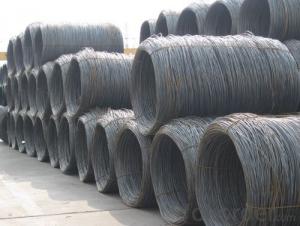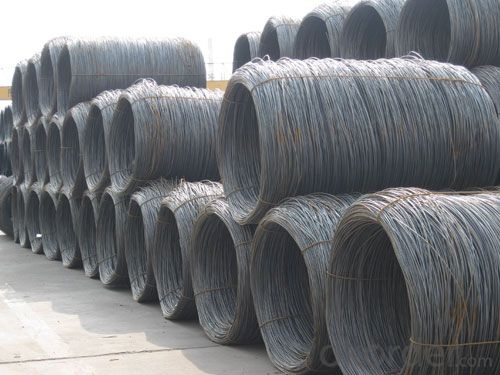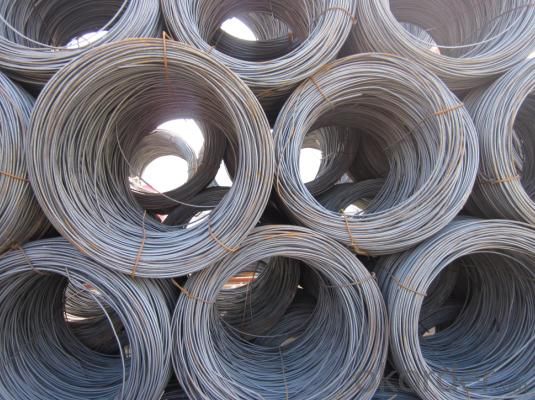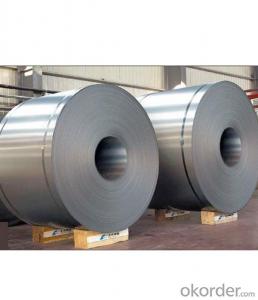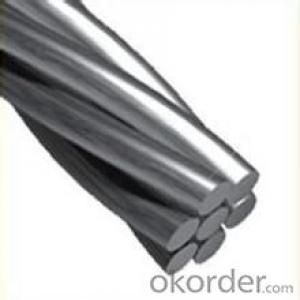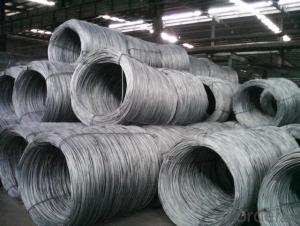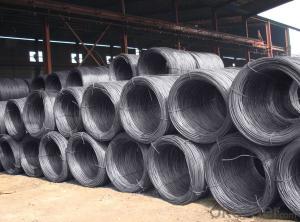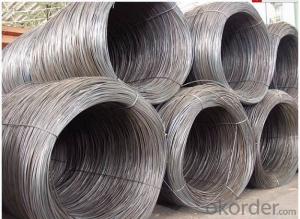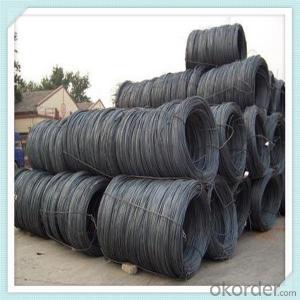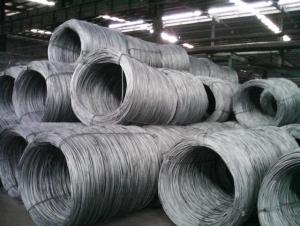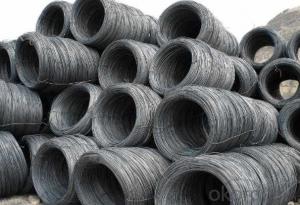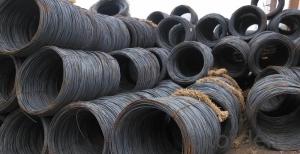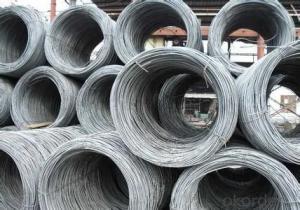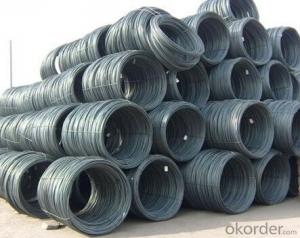High Quality Steel Wire Rod SAE1008 7mm/9mm/11mm
- Loading Port:
- Tianjin
- Payment Terms:
- TT or LC
- Min Order Qty:
- 50 m.t
- Supply Capability:
- 10000 m.t/month
OKorder Service Pledge
OKorder Financial Service
You Might Also Like
High Quality Steel Wire Rod SAE1008 7mm/9mm/11mm
Product Description:
Specifications of Wire Rod SAE1008:
Grade: SAE1008 Standard: ASTM
Diameter: 7mm/9mm/11mm
Alloy or Not: Alloy
Technique: Hot Rolled Place of Origin: China Mainland
Chemical Composition:
Please kindly find our chemistry of our material based on SAE1008 as below for your reference:
Grade | Chemical Composition (%) | |||||
C | Mn | S | P | Si | ||
SAE1008 | 0.10max | 0.32max | 0.045max | 0.040max | 0.30max | |
Mechanical properties | ||||||
Yield strength(N/mm2) | Tensile strength(N/mm2) | Elongation (%) | ||||
≥195 | 350-380 | ≥32 | ||||
Usage and Applications of High Quality Steel Wire Rod SAE1008 7mm/9mm/11mm:
After hot-rolled the products shaped into coil and delivery as finished product, including round, square,rectangular, hexagonal and so on. Since most of the products are round, it is generally called wire rod. Carbon steel wire rod is widely used in construction and manufacturing. Carbon steel wire rod is mainly used for reinforcement of reinforced concrete and welded structure or reprocessed (roberts , nail, etc.) materials, especially used to produce wire drawing, welding electrode, nails, spring, electronic, precise machinery parts and so on.
Packaging & Delivery of High Quality Steel Wire Rod SAE1008 7mm/9mm/11mm:
Packaging Detail: products are packed in coil and then shipped by container or bulk vessel
Each coil weight: About 2.05MT
Delivery Detail: within 45 days after received deposit or LC.
Label: to be specified by customer, generally, each bundle has 1-2 labels
Trade terms: FOB, CFR, CIF
FAQ:
Q1: Why buy Materials & Equipment from OKorder.com?
A1: All products offered byOKorder.com are carefully selected from China's most reliable manufacturing enterprises. Through its ISO certifications, OKorder.com adheres to the highest standards and a commitment to supply chain safety and customer satisfaction.
Q2: How do we guarantee the quality of our products?
A2: We have established an advanced quality management system which conducts strict quality tests at every step, from raw materials to the final product. At the same time, we provide extensive follow-up service assurances as required.
Q3: How soon can we receive the product after purchase?
A3: Within three days of placing an order, we will arrange production. The shipping date is dependent upon the quatity, how many sizes you want and the plan of production, but is typically 1 month to 2 month days from the beginning of production.
Images of High Quality Steel Wire Rod SAE1008 7mm/9mm/11mm:

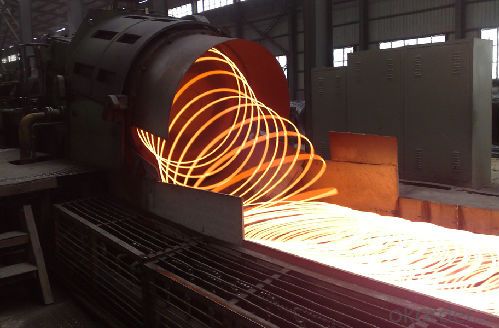
*If you would like to get our price, please inform us the size, standard/material and quantity. Thank you very much for your attention.
- Q: What are the standard tensile strength requirements for steel wire rod?
- The tensile strength requirements for steel wire rod vary based on factors such as the specific application, industry standards, and regulatory requirements. Generally, steel wire rod has a minimum tensile strength of 500 MPa or 72,500 psi to ensure it can withstand expected mechanical stress and loading conditions. It is worth mentioning that the required tensile strength may differ depending on the steel type, manufacturing process, and desired product properties. Hence, referring to industry standards or specifications is essential for determining the precise tensile strength requirements for a particular application.
- Q: What are the main challenges in the steel wire rod industry?
- Some of the main challenges in the steel wire rod industry include fluctuating raw material prices, intense competition from other materials like aluminum and plastics, increasing environmental regulations, and the need for constant innovation to meet customer demands and stay ahead in the market. Additionally, the industry also faces challenges related to maintaining high quality standards, optimizing production processes for efficiency, and addressing workforce skill gaps.
- Q: What are the main factors influencing the choice of steel wire rod order payment refund options?
- The main factors influencing the choice of steel wire rod order payment refund options include the terms and conditions of the purchase agreement, the level of trust between the buyer and seller, the reputation and financial stability of the supplier, the ease and cost of implementing different refund options, and the overall market conditions and industry practices.
- Q: How is steel wire rod used in the manufacturing of wire shelves?
- Steel wire rod is used in the manufacturing of wire shelves as it serves as the primary raw material. The wire rod is first formed into the desired shape and size, and then further processed to create the wire mesh that forms the shelves. The strength and durability of steel wire rod make it an ideal material for wire shelves, as it can support heavy loads and withstand daily wear and tear.
- Q: How is the corrosion resistance of steel wire rod improved?
- There are several methods and techniques available to enhance the corrosion resistance of steel wire rods. One effective approach is to apply protective coatings. Coatings made of zinc, aluminum, or other corrosion-resistant metals can be used to create a barrier between the steel and corrosive elements in the surrounding environment. These coatings act as sacrificial layers, corroding instead of the steel and extending the lifespan of the wire rods. Another way to improve corrosion resistance is through galvanization. This involves immersing the steel wire rod in molten zinc, which forms a protective layer on its surface. The galvanized coating acts as both a physical barrier against corrosion and a source of cathodic protection for the steel, minimizing the risk of corrosion. Corrosion resistance can also be enhanced by alloying the steel with specific elements. For example, stainless steel wire rods are widely used in applications where corrosion resistance is critical. Stainless steel contains a high percentage of chromium, which forms a self-repairing oxide layer on the surface, protecting the steel from corrosion. Additionally, the surface finish of the steel wire rod can influence its resistance to corrosion. Smoother and more polished surfaces tend to offer better protection against corrosion compared to rougher surfaces, as they have fewer crevices and imperfections for corrosive agents to penetrate. Proper maintenance and storage practices are also crucial for preserving the corrosion resistance of steel wire rods. This includes keeping them in dry environments, shielding them from moisture or corrosive substances, and promptly addressing any signs of corrosion, such as rust, by cleaning and applying suitable corrosion inhibitors. To summarize, enhancing the corrosion resistance of steel wire rods involves a combination of coating techniques, alloying, surface finishing, and proper maintenance. These measures ensure the longevity and performance of the wire rods in corrosive environments.
- Q: What are the standard surface roughness requirements for steel wire rod?
- The standard surface roughness requirements for steel wire rod typically vary depending on the specific industry and application. However, in general, the surface roughness for steel wire rod is usually specified to be within a certain range, such as Ra 0.8-1.6 µm (micrometers) or Ra 32-63 µin (microinches). These requirements ensure that the surface of the wire rod is smooth enough to meet the desired performance and functionality while also allowing for efficient processing and handling.
- Q: What are the main regions for steel wire rod production?
- Asia, Europe, and North America are the primary regions where steel wire rod production takes place. In Asia, China, Japan, and India are the leading countries in steel wire rod production. China, in particular, holds the largest share of global production due to its extensive steel industry and strong domestic demand. Japan is also a significant player, known for its advanced technology and high-quality steel products. India has emerged as a major producer in recent years, driven by its expanding infrastructure and construction sectors. Europe, on the other hand, boasts prominent steel wire rod producers such as Germany, Italy, and France. Germany, with its long history of steel manufacturing, is renowned for its expertise in producing top-notch steel wire rod. Italy specializes in stainless steel wire rod production and is also a significant player in the industry. France benefits from its strategic location and serves as a hub for steel wire rod distribution throughout Europe. North America is another crucial region for steel wire rod production, with the United States and Canada playing key roles. The United States has a well-established steel industry and is known for its advanced production techniques. Canada, although not as large a producer as the United States, still makes a significant contribution to the North American market. Overall, these regions dominate global steel wire rod production and each has its own strengths and specialties. The demand for steel wire rod continues to grow, fueled by various industries such as automotive, construction, and manufacturing, ensuring a strong market for these regions.
- Q: What are the main factors affecting the hardness of steel wire rod?
- The main factors affecting the hardness of steel wire rod include the carbon content of the steel, the presence of other alloying elements, the heat treatment process used, and the mechanical deformation applied during wire drawing.
- Q: How are steel wire rods used in the manufacturing of welding wires for joining metals?
- Steel wire rods are used in the manufacturing of welding wires for joining metals by being drawn down to the desired size and coated with a flux material. This process ensures that the welding wire has the necessary strength and durability to effectively join metals together during the welding process.
- Q: How is the surface quality of steel wire rod evaluated?
- The surface quality of steel wire rod is evaluated by visually inspecting for any defects or imperfections on the surface, such as scratches, pits, cracks, or other surface irregularities. Additionally, the rod may undergo non-destructive testing methods like magnetic particle inspection or ultrasonic testing to identify any hidden flaws or internal defects.
Send your message to us
High Quality Steel Wire Rod SAE1008 7mm/9mm/11mm
- Loading Port:
- Tianjin
- Payment Terms:
- TT or LC
- Min Order Qty:
- 50 m.t
- Supply Capability:
- 10000 m.t/month
OKorder Service Pledge
OKorder Financial Service
Similar products
Hot products
Hot Searches
Related keywords

